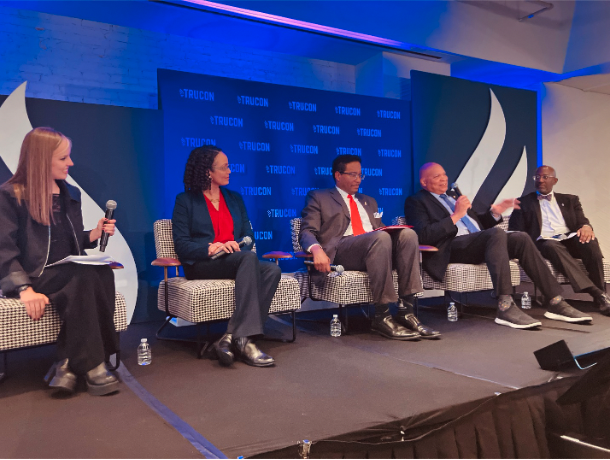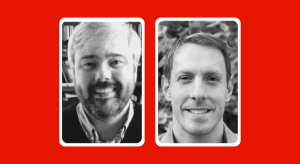‘You’ve got to see it to be it’: Leaders aim to inspire more diverse tech talent for national security

Pentagon and intelligence community components, and their research and academic partners, are increasingly capturing and applying data in more intentional ways to better understand and inspire their technology-focused personnel and to help expand the government’s pool of diverse STEM talent, four senior experts told DefenseScoop.
“We need more great people bringing their ideas to the table. And these people come from all over the country. They come from all sorts of backgrounds,” Principal Deputy Director of National Intelligence Stacey Dixon said.
During a panel moderated May 31 by DefenseScoop at the Truman Center’s 2024 TruCon summit, Dixon and three other longtime innovators shared new details about their unfolding efforts to help build and foster a national security workforce pipeline that reflects the entire spectrum of talent America has to offer, and how these pursuits are informed by their own personal experiences.
The IC
Dixon is the highest-ranking African American woman serving in the intelligence community and the first person of color ever confirmed for her job.
“I do think it’s important to acknowledge these sorts of historical firsts. Then, my personal preference is, ‘OK, let’s move past that and let’s get to work.’ So, I don’t want to be remembered as being the first. I want to be remembered for what I’ve delivered as part of this job. And I think that’s true for many of us,” she said.
One move she and other panelists said they made that contributed to their professional success as early Black innovators in highly technical fields, involved seeking out a variety of role models who are — and are not — African American.
“There were days where I would walk into rooms being the principal person leading a meeting, and people would still be waiting for the principal person leading the meeting to walk into the room. And you can either let that impact you or you can move on and kind of keep going. I don’t encounter that anymore in this role. People know that I’m going to be showing up as me, so it’s not surprising anymore. But there were those moments and there were those days,” Dixon recalled.
“So it’s important to have in your network not only people who look like you and who have shared experiences, but a broader network of just great people that work in these wonderful organizations that all of us are part of, who are advocates and who are partners who are willing to look at you and what you can deliver,” she said.
Since 2016, the Office of the Director of National Intelligence has been releasing annual public reports presenting data-based trends on workforce demographics across the IC.
“This is a report that is required by Congress that we produce every year, and we are very close to posting the fiscal year 2023 report on our website. And what’s new about it this year is that we actually have intersectional data,” Dixon announced during the panel.
Broadly speaking, she said that means her team for the first time is leveraging demographics and gender data on “every person in our intelligence community,” that they can then break out to analyze different trends within the different populations of IC employees. The ability to track and engage with those data points is enabling Dixon and other officials to better gauge and help mitigate barriers to the workforce.
“The data is wonderful. We actually see that our recruiting efforts are increasing and improving, and we’ve got much more diversity coming into the pipeline,” she said.
However, retention data within the IC is not displaying similar improvements.
“We see, frankly, that there are minorities that are leaving in the first five years of employment in the intelligence community in a way that we didn’t actually know that as a fact that now we can kind of dive in and see what is it — is it the lack of belonging, is that lack of opportunities — so that we can then create programs that actually target these things,” Dixon noted.
“We had anecdotes before, and we had personal experiences. But now the data to actually pull those two strings together is extremely powerful,” she said.
Diversity and national security
When Maynard Holliday studied mechanical engineering at Carnegie Mellon University, he was one of only 15 African American engineers in his class.
“Fifteen started, but only three of us graduated, and it was baptism by fire,” Holliday told DefenseScoop. “But we had support mechanisms that are now currently known as [diversity, equity and inclusion, or DEI initiatives],” Holliday — who is performing the duties of assistant secretary of defense for critical technologies in the Office of the Under Secretary of Defense for Research and Engineering — added.
Working across multiple administrations, in academia and the tech sector over his decades-long career, it’s always been a priority for him to help promote and expand diversity across the government technology talent base.
So, when Holliday worked in the Pentagon with another now-former defense official who also spoke on the panel, Jaret Riddick, the two of them were “able to make the case based on data” to their then-boss Frank Kendall, who’s now the secretary of the Air Force Secretary.
“In the administration beforehand, [Kendall] had a sign on his door [that said] ‘In God, we trust. All others bring data,” Holliday noted.
“We met the moment and made that point that I’ll footstomp — 25% of Black STEM bachelor’s degrees come from [historically Black colleges and universities]. And 50% of Black, female STEM PhDs come from HBCUs,” he said.
Ultimately, their team was able to convince Defense Department and Air Force leadership to make a historic investment to have a consortium of HBCUs tackle intensifying military challenges around tactical autonomy.
“So we were able to get funding a year ago — the floor is $90 million over five years,” Holliday confirmed.
Not long after that, Kendall announced Howard University was tapped to serve as the 15th University Affiliated Research Center (UARC), focusing on tactical autonomy. The university made history as the first HBCU to lead a UARC, and the first center to be funded by the Air Force.
“And we were just talking to Dr. Dixon earlier this week about the intelligence community’s potential in sourcing some tasks for these schools. And so, this is something that was really important to us and as I said, the legacy long after I’m out of the job,” Holliday said.
Like Holliday, Riddick is also an engineer with decades of expertise. He now serves as a senior fellow at the Center for Security and Emerging Technology, where he’s diving deep into demographics and other data to study a range of topics associated with systemic issues pertaining to diversity and the American workforce.
“We face this emerging great power competition between Russia, the United States and China. Recently for CSET, I looked at world leaders in STEM — these are numbers that have not been really updated publicly since 2016. And we can see the tremendous gap between China and the United States actually, in that list of top STEM producers,” Riddick explained.
He said the U.S. is trailing behind “in terms of STEM production” during what’s considered “a race for technological dominance.”
Recognizing that there are “vast numbers of folks that have pools of talent that are not in the technology sort of discussion today,” Riddick said he’s now exploring research to see whether “technology-based economic development” can be a tool to bring new members into the conversation.
Amid this contemporary great power tussle, he added, underrepresented and underserved communities are also confronting new vulnerabilities and susceptibility from adversaries.
“Think about the Senate Intelligence Committee report on the 2016 Russia meddling in the election. They said in [that] bipartisan report that these efforts targeted the Black community in the U.S. more than any other. It was a concerted effort to drive down Black voter turnout, and so this shows you that there’s a threat vector around issues of disparity and equity that our capable, near-peer adversaries are willing to exploit,” Riddick said.
“For us, in the United States, diversity has always been an asset. And now in this new competition with near-peer adversaries targeting this, we have a new reason to think about how we use this diversity as an asset,” he said.
“We can’t have anybody left behind in our pipeline,” Holliday added.
Planting seeds
After graduation, Holliday was recruited by Lawrence Livermore National Laboratory in California, where he met Darryll Pines, who now serves as an aerospace engineering professor and president of the University of Maryland.
“When you’re in these environments where you are the ‘only’, there’s an attraction when you see somebody of color walking around the spaces where normally they are not. And so when I saw Dr. Pines when he joined Livermore some years after I did, we had to talk about our experiences and how we got to these places. And we’ve been mutually supporting one another over our careers,” Holliday said.
That mutual support recently appears to have come uniquely full circle.
On May 28, the University of Maryland under Pines’ leadership announced that it was selected to receive a new contract with a $500 million ceiling from the DOD to support the institution’s Applied Research Laboratory for Intelligence and Security, which was then designated as a new UARC.
“We’re super excited. It’s the largest contract in the history of the University of Maryland — but it’s more important than just that,” Pines said during the panel. “This is important because it allows the university to play a role in our national security enterprise, and to accelerate another very important part of developing the workforce of the future that is diverse.”
Pines also shared another recent “first” for the university under his purview that could help introduce and engage students from all backgrounds to an emerging and disruptive technology that will likely impact their lives and careers in the future.
“It’s across the entire university. Going forward starting in the fall of this year, every student — there’s 41,000 — will have to take an artificial intelligence class, because we think it’s so transformative that it’ll affect every domain space,” Pines told DefenseScoop.
“It’s important that they expose young people to all kinds of STEM opportunities,” he emphasized.
Each of the other panelists echoed that aim as one of their own.
“It’s so critical. Whenever we travel around the country, my team knows that we want to find a university or high school — or both — that has a very diverse population and that frankly, our community has not actually gone and visited before. So, I’m exposing them to the idea about careers in public service, careers in national security, and of course, careers in the intelligence community, because so many students are not exposed to it. They don’t even see it as a possibility for them going forward. And so, just planting that seed really is wonderful,” Dixon said.
Inspired by the organization Black in AI and the computer scientists who launched it, Holliday co-founded Black in Robotics in the aftermath of the George Floyd protests. In between serving presidential administrations, he said, he also opted to teach robotics to young people in Oakland “for that reason: to inspire.”
“We’ve all heard the old adage, ‘You’ve got to see it to be it.’ And so, I wanted to see somebody like myself doing that,” Holliday said.
Riddick added: “From my perspective, I have this slogan that I shared with a friend of mine recently, it’s ‘Technology is the key to the unfinished business of civil rights.’ We heard the New York governor recently stated that kids in the Bronx can’t even spell ‘computer.’ But what would it look like to have a, no kidding, research center in the Bronx doing research and engaging communities? This is how I think about this … So, I’m looking at this technology piece really filling in long-term sort of challenges and to take on a new perspective of great power competition.”



